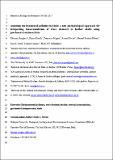Por favor, use este identificador para citar o enlazar a este item:
http://hdl.handle.net/10261/155973COMPARTIR / EXPORTAR:
 SHARE SHARE
 CORE
BASE CORE
BASE
|
|
| Visualizar otros formatos: MARC | Dublin Core | RDF | ORE | MODS | METS | DIDL | DATACITE | |

| Título: | Assessing environmental pollution in birds: a new methodological approach for interpreting bioaccumulation of trace elements in feather shafts using geochemical sediment data |
Autor: | Borghesi, Fabrizio; Dinelli, E.; Migani, Francesca; Bechet, A.; Rendón-Martos, Manuel; Amat, Juan A. CSIC ORCID; Sommer, Simone; Gilliham, M.A.F. | Palabras clave: | Feather External contamination Geochemical interpretation Birds Trace elements Environmental pollution |
Fecha de publicación: | 2017 | Editor: | John Wiley & Sons | Citación: | METHODS IN ECOLOGY AND EVOLUTION 8: 96- 108 (2017) | Resumen: | Environmental trace element composition can have an important impact on ecosystem and population health as well individual fitness. Therefore, carefully assessing bioaccumulation of trace elements is central to studies investigating the ecological impact of pollution. Colonial birds are important bioindicators since non-invasive sampling can easily be achieved through sampling of chick feathers, which controls for some confounding factors of variability (age and environmental heterogeneity). However, an additional confounding factor, external contamination (ExCo), which remains even after washing feathers, has frequently been overlooked in the literature. We developed a new method to reliably interpret bioaccumulation of 10 trace elements (As, Cd, Cr, Cu, Hg, Ni, Pb, Se, Sn and Zn) in feathers using chicks of a colonial species: the Greater Flamingo, Phoenicopterus roseus. First, only shafts were used to remove ExCo retained in vanes. Secondly, we applied a thorough washing procedure. Thirdly, we applied a new analytical method to control for ExCo, which assumes that ExCo is mainly due to adhered sediment particles and that the relative concentration of each trace element will be similar to the sediment geochemical composition of sampling sites. We validated this new methodology by comparing trace element composition and particle composition (by scanning electron microscopy and mass spectrometry) of washed and unwashed feathers. The washing procedure removed >99% of K indicating that most of the ExCo from salt was removed. Scanning electron microscopy and mass spectrometry revealed that some sediment particles remained after washing, especially clays which are likely to severely bias bioaccumulation interpretation. We successfully controlled for ExCo by calculating the ratio of ExCo due to sediment using the geochemical fingerprint of sediment samples. Our methodology leads to conservative estimates of bioaccumulation for As, Cd, Cr, Cu, Hg, Ni, Pb, Se, Sn and Zn. We have validated a new more reliable method of analysing trace element concentrations in feathers, which effectively controls for ExCo, if geochemical sediment data can be meaningfully compared to ExCo of feathers. We have demonstrated that overlooking ExCo leads to potentially erroneous conclusions, and we urge that the method applied in this study be considered in future studies. | URI: | http://hdl.handle.net/10261/155973 | DOI: | 10.1111/2041-210X.12644 | Identificadores: | doi: 10.1111/2041-210X.12644 issn: 2041-210X |
| Aparece en las colecciones: | (EBD) Artículos |
Ficheros en este ítem:
| Fichero | Descripción | Tamaño | Formato | |
|---|---|---|---|---|
| Borghesi_et_al_MEE_Final.pdf | 1,24 MB | Adobe PDF |  Visualizar/Abrir |
CORE Recommender
SCOPUSTM
Citations
33
checked on 21-abr-2024
WEB OF SCIENCETM
Citations
25
checked on 27-feb-2024
Page view(s)
346
checked on 22-abr-2024
Download(s)
680
checked on 22-abr-2024
Google ScholarTM
Check
Altmetric
Altmetric
NOTA: Los ítems de Digital.CSIC están protegidos por copyright, con todos los derechos reservados, a menos que se indique lo contrario.
